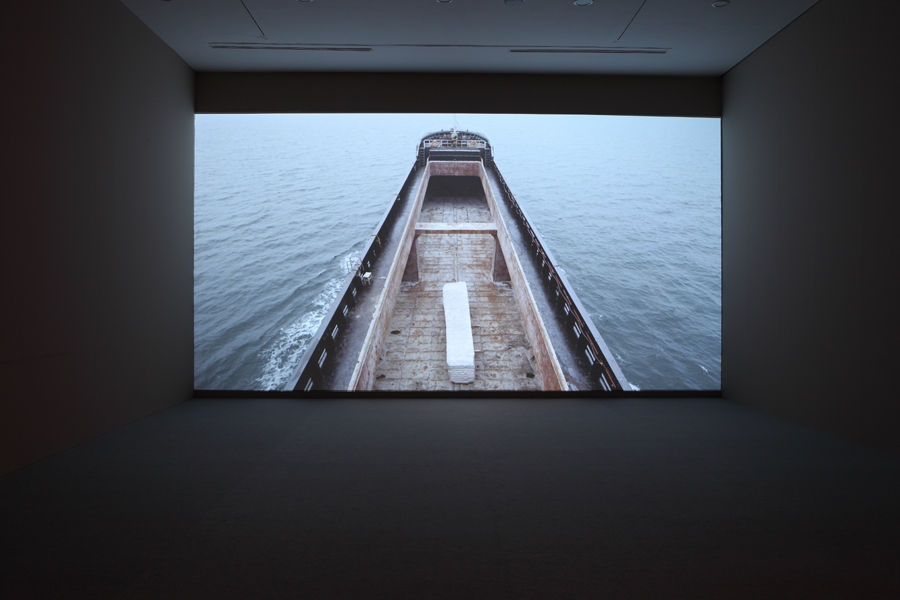Busan is the second biggest city in Korea, and the recent edition of its Biennale, titled Inhabiting the World, is focused on the role of art in today’s world. According to artistic director Olivier Kaeppelin, our world is facing a wideranging and multilayered crisis, involving the disappearance of subjectivity, the failure of sensibility and the loss of harmony between humankind with its personal and intimate dimension. Therefore, he proposes that only through art – the multiple perspectives provided by the artists or the frontal confrontation with an artwork – will people be able to act as researchers or experiencers, to discover differences, to test the forms, to return to personal experience, thus to participate in the comprehension of the world, to ‘inhabit the world’.
To realise his aim, Kaeppelin encourages the viewer to take the attitude of a walker and an explorer, to encounter artworks that fill the three-level space of Busan Museum of Art, divided by seven subthemes or subsections: ‘Movement’, ‘The Cosmos and the Sky’, ‘Architecture and Object’s Mobility’, ‘Identities Represented’, ‘Animal’s Dialogue’, ‘The History, The War’ and ‘Nature As Witness’. Indeed, each subtheme sounds worthy of exploration, but as a whole it just lacks a certain focus, or an indepth logical connection, and can’t save the Biennale’s theme from being too generalised.
Moreover, it is a biennial inside a multigallery museum building, and apparently the curatorial team has no ambition to challenge or play with the existing structure of space. Most subsections obtain their own gallery hall, and some invade the lobby, passage or other ‘in-between’ spaces. The visual aesthetics of the biennial is nearly ‘old-fashioned’, with a large amount of paintings hanging on the white walls and sculptures placed on the wood floors. However, there are indeed a few works that are relatively arresting. For example French artist duo Art Orienté Objet’s May the Horse Live in Me (2011), in which one of the artist wears prosthetic horse legs and takes a few steps and injects horse blood into her body. It is an interesting, crazy experiment on making a new kind of being, a ‘trans-human’, which explores intersections of ethology, genetics and hybridisation from a scientific rather than a mythological perspective. It is also interesting to connect Indian artist Jitish Kallat’s work with Korean artist Kimsooja’s, as they both showcase some sort of ‘Asian taste’ via ingenious lighting. Kallat’s Breathe (2012) is an installation of seven videos, each showcasing an Indian bread slowly vanishing, simulating different phases of the moon, and creating a connection between everyday routine and universal rule. Kimsooja’s To Breathe: Mandala (2010) provides an immersive space, a bodhimanda (place of enlightenment) or ritual room that allows religious and cultural symbols to affect the viewer’s inner energy – an old oriental nonmaterial power reintroduced to today’s world by the New Age movement.
It reveals the crisis of some city biennials in Asia: the growing gaps between the organiser, the commissioned Western curator or artistic director and the local art scene
At the preview there were many Frenchspeaking artists and only a few Korean artists, which revealed the dark shade clouded over the Biennale: it is said that the local art scene was protesting because the artistic director was chosen by the organiser through an improper procedure. It was more ironic when people recalled the fact that the Busan Youth Biennale – the precursor of the Busan Biennale – was founded in 1981 by local artists. And it also reveals the crisis of some city biennials in Asia (sadly not the minority): the growing gaps between the organiser (normally the city government or the offcial institution under its structure), the commissioned Western curator or artistic director and the local art scene that has developed in the last decades. And it is those gaps, each caused by specific historical and actual reasons, that cause the biggest problem for the biennials in this region.
Apart from the theme show in Busan Museum of Art, the Biennale also extends to other places in the town, with an archive exhibition, Voyage to Biennale, and an Asian curatorial project, Going, Going, Until I Meet the Tide. Voyage to Biennale, which takes place in Busan Cultural Center, looks back on the 50-year history of Korean contemporary art in overseas biennials. For viewers who are interested in Korean art, the show does provide a brief history and image, and a fertile resource for research, with plenty of text and picture materials and interviews (unfortunately most of which are in Korean only). However, the historical narrative provided in this show is full of a nationalist sense of pride, which also proves the fact that the Westernoriented biennial mechanism is serving, in this region, as a recognition system and hence a new tool of culture colonisation. Going, Going, Until I Meet the Tide, titled after a line from English poet John Masefield’s ‘A Wanderer’s Song’ (1902), is located at the old storehouse in KISWIRE Sooyoung Factory and curated by four young curators from Korea, Japan, China and Singapore. The show, with its booth-based, art-fair-like layout, has produced a vigorous atmosphere and some freshness, with works by 36 young artists – a beautiful tribute to the old Busan Youth Biennale!
This article was first published in the Spring 2015 issue of ArtReview Asia.
